Are Water Fountains Good for Cats?

As a cat parent, you understand that our feline friends deserve nothing but the best. This means prioritizing their well-being and identifying potential health risks you can prevent. One such risk you should be familiar with is dehydration. Ensuring your cats drink enough water to meet their daily needs can be challenging. If you’re currently struggling with this, I am here to help.
Check out this article for tips and tricks to encourage your cat to drink more water. Plus, I’ll share why we love water fountains for all pets in our home.
Do Cats Get Dehydrated Easily?
While any pet may struggle with dehydration, it’s surprisingly common among cats. Why? Unlike dogs and other pets, most cats don’t have the desire to drink plain water. Experts say that this can be traced back to their roots.
In the wild, cats are obligate carnivores – meaning they depend strictly on meat for survival. Meat contains high moisture levels, allowing them to obtain most of the water they need through their food. However, the same can’t be said with the shift to commercial cat foods and treats, especially dry kibble. This makes it more important than ever for cat parents to be proactive with hydration.
Signs of Dehydration in Cats
Even if you’re diligent about encouraging your cat to drink enough water daily, it is always possible that they will fall short of their hydration needs. This is further compounded by the fact that several medical conditions and illnesses can increase the risk of dehydration.
Be on the lookout for these signs of trouble:
- Panting
- Sunken eyes
- Dry or tacky gums
- Refusal to eat or take treats
- Constipation
- Loss of skin elasticity
- Increased heart rate
- Weakness or lethargy
Contact your veterinarian if you notice any warning signs of dehydration in your cat. They may be able to provide you with some guidance for treatment over the phone. Avoid forcing your cat to drink water, especially using a dropper or syringe. These tools can be helpful in some settings, but they also carry the risk that the fluid enters their lungs, causing pneumonia. Consider offering Pedialyte or canned cat food, which contains as much as 80% water.
In severe dehydration cases, you will need to take your cat to the nearest veterinarian or emergency clinic for the necessary medical intervention to avoid serious and potentially life-threatening complications.
How to Check Skin Elasticity
The skin tent test is one of the most effective ways to test whether your cat is suffering from dehydration. To test this, you will take a small piece of your cat’s skin at the back of their neck, between the shoulders, between your thumb and forefinger. Gently pull this skin up and then release it, watching the skin respond. If the skin falls right back down quickly, your cat is properly hydrated.
If, however, the skin remains in a tented position, this indicates that your cat is dehydrated, and you should contact your veterinarian. The longer it takes for the skin to return to its original position, the more severe the dehydration.
One important point to note is that skin elasticity does not remain consistent throughout your cat’s life. As they age, the skin elasticity may decrease, meaning that the skin may remain tented for a short time even when fully hydrated. If you’re unsure or notice tenting in combination with any other warning signs of dehydration, it’s better to be safe than sorry!
Common Causes of Dehydration in Cats
Failure to drink enough water isn’t the only potential cause of dehydration. There is also the possibility that this is a sign of a bigger health problem. If so, the only way to treat your cat’s dehydration is first to identify the cause. These medical explanations may be a minor illness or symptom, or they could be a serious lifelong illness that will require proper ongoing management.
Some illnesses or medical conditions that could lead to dehydration include:
- Vomiting or Diarrhea: Whether your cat is experiencing a stomach bug or struggling with gastrointestinal problems from a more severe health issue, vomiting and diarrhea cause your cat to lose large amounts of water. Even if they drink normally, losing more water than they can replace will lead to dehydration.
- Hot Weather, Heat Stroke, Heat Exhaustion: As your cat’s body overheats, they will lose excessive amounts of water through sweating and panting to cool themselves off.
- Fever: Like the above-mentioned heat-related illnesses, a fever means a noted increase in your cat’s body temperature. As this temperature rises, even if the exterior temperature is cool, the body will respond by trying to cool off and expelling large amounts of water.
- Diabetes: If the kidneys cannot keep up with the excess glucose in the body, they will try to eliminate it to balance the system again in your cat’s urine. However, to do this, the body expels large amounts of water carrying this glucose, taking fluids from otherwise healthy tissues.
Other medical conditions associated with dehydration include hyperthyroidism, heart disease, chronic kidney disease, renal disease, or traumatic injuries.
How Do I Get My Cat to Drink More Water?
Like most medical struggles with multiple potential causes, there is no “one-size-fits-all” solution to dehydration in cats. Instead, you must consider the situation leading up to this point and how to address it appropriately. This often involves a combination of medical treatment for any underlying causes and encouraging your cat to drink more water and improve their hydration levels. But how do you get your cat to drink more water? Here are a few tips and tricks that you can use:
Flavor Your Cat’s Water
Adding a small amount of salmon or tuna juice from the can or a pet-friendly broth to your cat’s water may provide enough temptation to convince your cat to try it. Check the ingredients of any product you choose to ensure it is safe for your cat. Pay careful attention to sodium levels, using only low-sodium or sodium-free products to avoid salt poisoning.
Rehydrate Your Cat’s Kibble
A good practice to get into if you are kibble-feeding your cat is to rehydrate their kibble. This means adding water to the kibble. Alternatively, you can use other forms of moisture, like mixing in canned foods or adding bone broth (homemade or commercially purchased) to your cat’s meal.
Clean Your Cat’s Bowls Daily
Your cat may be bothered by a smell or the presence of dirt and dust in their dish. This can easily be addressed by cleaning your cat’s dish every day. It ensures that they have clean, fresh water available at all times. It is also a great way to remind yourself to fill their dish regularly so that it never runs low.
Ensure Water is Easily Accessible
If your cat must work for their water, they likely will overlook it entirely. This includes traveling too far to find it, contending with obstacles like stairs, or needing to pass through a high-traffic location to get to it. If you’re concerned this may be part of your cat’s challenge, consider placing additional water dishes around the home in their favorite places.
Do you have more than one cat? In some situations, a cat becomes possessive of a water dish, protecting it from other pets in the house. If this is the only water dish currently in place, this would mean one of your cats is restricted from being able to drink at all. If you notice any bullying or resource guarding, consider it a sign that you must make more resources available.
Experiment with Bowl Size, Shape, and Material
Cats can be very finicky, with preferences regarding what dishes they eat or drink from. If your cat is reluctant to drink from the water dish you have given them, consider experimenting with different options. Try a larger bowl or a shallow bowl with a lower side for them to reach over. Try plastic, stainless steel, and ceramic bowl options. With each new bowl, take note of your cat’s reaction to identify which they like best and which they avoid.
Try a Water Fountain
Another great option to encourage your cat to drink more water is to switch from a standard water dish to a water fountain. Some cats refuse to drink still water unless they have no other choice, drinking from running or dripping taps in the house instead of a dish. The water movement in the fountain naturally attracts cats that otherwise may not pay attention to their water dish. They also keep the water fresh and cool, making it more enticing.
Where Should I Put My Cat’s Water Fountain or Dish?
An important consideration when it comes to whether your cat will drink out of their water dish is the placement of the dish and its surroundings.
First, ensure your cat’s water dish is separate from the other “key” areas. Why? Cats naturally don’t want to drink in the same place where they eat or go to the bathroom. This is a survival instinct that dates back to their wild ancestors to avoid drinking water that had been contaminated by their waste or bacteria from their prey. When possible, set these areas up in different rooms from one another. If it’s not possible, at least be sure you are placing as much space between them as possible, given the room available.
You should also take note of any other activities happening in the space. If your cat’s water dish is in a high-traffic room of your home, there may be too much going on to allow them to drink comfortably. Other things to look out for include fans that could create uncomfortable air movement, off-putting smells (even if you think they are pleasant), or other pets in the home with access to that area. Create a space where your cat can enjoy a relaxing drink without interruptions or distractions.
Our Solution: Catit LED Flower Fountain with Triple Action Filter
From a young age, we noticed that our one cat Pippen always preferred moving water. She would happily run over to drink from the water tap each time we turned it on. However, we didn’t want just to leave the tap running all day and night! Before long, our younger cat also seemed to pick up on these habits, and we were searching for a reasonable way to handle this. Our solution was to bring a water fountain into the home and see if they showed the same level of interest.
We chose the Catit LED Flower Fountain for several reasons. First, the flower design on the top of the fountain created multiple streams of water, allowing both cats to comfortably drink simultaneously without having to compete.
Second, we knew this water fountain had a more comprehensive filtering system. It includes a triple-action softening cat filter that helps to remove any dirt, dust, and impurities in the water. If there is any sign of something in her water dish, our cat Jinx turns up her nose. With the water continually moving through this filter, we knew that she would always have clean, filtered water waiting for her, even if we weren’t around to check it several times daily.
After testing a single fountain and watching their response, we have since expanded to add two more. There are currently fountains in the dining room of our home, on a secluded staircase up to the loft where they can hide away from any company and enjoy a drink, and back in the bedroom and office area. This setup has considerably impacted their water intake (in a positive way).
Pros
- Moving water attracts and entices cats to drink more
- Water is always fresh and filtered
- Cools water as it circulates throughout the day
Cons
- More expensive investment, including ongoing filter costs
- Take more work to clean than a standard water dishes
- Can only be set up in areas where you have access to a power outlet
Final Thoughts
As with any potential health risk, dehydration is an important topic that all cat parents should familiarize themselves with. If left unaddressed, it can lead to severe and potentially life-threatening complications. Luckily, in most cases, it can be easily addressed by making a few changes around your home to the location of your cat’s water dish and the style of dish available. Introducing a cat water fountain with a built-in filtration system is an excellent solution for those cats who are extra finicky about their water. It’s a great way to be proactive and improve your cat’s overall health and well-being.

Britt Kascjak is a proud pet mom, sharing her heart (and her home) with her “pack” which includes her husband John, their 2 dogs – Lucifer and Willow – and their 2 cats – Pippen and Jinx. She has been active in the animal rescue community for over 15 years, volunteering, fostering and advocating for organizations across Canada and the US. In her free time, she enjoys traveling around the country camping, hiking, and canoeing with her pets.
More by Britt























